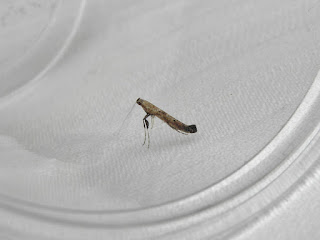Rare Acleris micro in Town
Chepstow Town
November 23rd and December 3rd
One of my wanders around the town on the 23rd November produced this intriguing micro moth, upon which I left on my camera for several days before having a serious close up look.
I had thought it was a Light Brown Apple Moth from a distance for it had settled high up on a whitewashed wall on a building and was nearly out of reach of my cameras focal distance.
After looking closer at the better of two pictures I took, I sent it off to Sam assigning the name of Acleris Umbrana totally oblivious of its county and national status.
Although not pin sharp, the distinctive black longitudinal streaks were clearly visible along with the odd scale tufts and there really was not any doubt that this is was what it was.
Sam Bosanquet agreed and commented that it was a recent new addition to the county list only as of this year, 2017.
Dark-streaked Button- Acleris umbrana
The photographs here are from another encounter dated 3rd December where thankfully another or maybe the same moth had perched lower down the same wall conveniently providing a better opportunity for me to take a closer view. You can see the 'streaks' and 'tufts' better in these pictures.
Although I could not manage to produce photographic at the time, I strongly believe that this moth was at this site last year. Again it was positioned high up on the wall like the encounter this year albeit much higher up and out of reach of the camera.
I did some further reading up on the Dark-streaked Button, Acleris umbrana, and its National status is in the 'Scarce A' category at present, 'a rare and localised species'.
I particularly like the comment made by Sheldon in 1930 where he describes the moth as a 'rather mysterious species' always very local, never common and entirely disappearing from its known haunts for years at a time'.
Forty-three years later his observations/comments were echoed by Bradley, Tremewen and Smith as they also found it elusive for years at a time at known sites, so very little had changed in 1973.
Could it be that in future that the moth will frequent known habitats here in Gwent and then inexplicably disappears for long periods only to return....could be an interesting experimental exercise for the people who have found it so far possibly.


















































